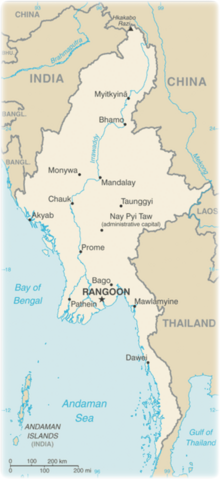
General Information
| Languages : | Burmese |
| Currency : | kyat (K) (mmK) |
| Time Zone : | EST +11.5hrs |
| Capital City : | Rangoon (Yangon) Naypyidaw is administrative Capital |
| Population : | 50.5 Million |
| Government : | Military junta |
| Total Area : | 261,228 mi² |
| Climate : | Tropical monsoon; cloudy, rainy, hot, humid summers (southwest monsoon, June to September); less cloudy, scant rainfall, mild temperatures, lower humidity during winter (northeast monsoon, December to April) |
| National Holidays: | Independence Day, 4 January; Union Day, 12 February |
| Additional Info: | Also known as Burma. Myanmar remains one of the most mysterious and undiscovered destinations in the world. A land of breathtaking beauty and charm yet only recently emerging into the modern world. |
Destination Activities
Activity Details
Cultural Activities
Myanmar, which is also known as Burma and is officially the Union of Myanmar, is the largest country by geographical area in mainland Southeast Asia.
Yangon or Rangoon is the largest city of Myanmar. The city is located at the convergence of the Yangon and Bago Rivers about 19 miles away from the Gulf of Martaban. While visiting the city, don't miss the Shwedagon Pagoda, a 320ft gilded stupa located in Yangon, Myanmar. The pagoda lies to the west of Kandawgyi Lake, on Singuttara Hill, thus dominating the skyline of the city. It is the most sacred Buddhist pagoda for the Burmese with relics of the past four Buddhas enshrined within, namely the staff of Kakusandha, the water filter of Konagamana, a piece of the robe of Kassapa and eight hairs of Gautama, the historical Buddha.
Kandawgyi Lake is one of two major lakes in Yangon, Myanmar, located east of the Shwedagon Pagoda. The lake is artificial and was created to provide a clean water supply to the Cantonment (modern-day Downtown) of Rangoon during British colonial administration. Karaweik Hall is a landmark of Yangon, locating in Kandawgyi (Royal) Lake. This modern architecture of a mythical creature Karaweik, has 3 floors and ceremonies are held in it. This whole building was gilded with gold about 20 years ago.
Bagan was the ancient capital of several ancient kingdoms in Myanmar. It is located in the dry central plains of the country, on the eastern bank of the Ayeyarwady River, 90 miles southwest of Mandalay. Here explore the Shwezigon Pagoda, the proto type of later Myanmar Stupa. The Sulamani Temple is noted for its finest brickwork and the pilaster carving while the Dhamanyangyi Temple presents the most massive temple that has never been damaged by the Natural disasters, Ananda Temple, the masterpiece of Bagan was built in the form of perfect Greek cross.
The Payathonzu Temple is a Buddhist temple located in the village of Minnanthu (southeast of Bagan). It is unique in the sense that the temple consists of three temples conjoined through narrow passages. The interior of the temple contains frescoes, believed to be Mahayana and Tantric in style. However, the temple was not completed. The temple was recently renovated, with the completion of the three stupas atop the temple, which are lighter in color.
Mandalay is the second largest city in Myanmar. It is Myanmar's cultural and religious center of Buddhism, having numerous monasteries and more than 700 pagodas. At the foot of Mandalay Hill sits the world's official "Buddhist Bible", also known as the world's largest book, in Kuthodaw Pagoda. There are 729 slabs of stone that together are inscribed with the entire Buddhist canon, each housed in its own white stupa. While in Mandalay, visit the Shwenandaw Monastery, the only remaining apartment of Mandalay Palace.
Ecotourism
Myanmar's slow economic growth has contributed to the preservation of much of its environment and ecosystems. Forests, including dense tropical growth and valuable teak in lower Myanmar, cover over 49% of the country. Other trees indigenous to the region include rubber, acacia, bamboo, ironwood, mangrove, coconut, betel palm. In the highlands of the north, oak, pine, and various rhododendrons cover much of the land. The lands along the coast support all varieties of tropical fruits. In the Dry Zone, vegetation is much more sparse and stunted.
Typical jungle animals, particularly tigers and leopards, are common in Myanmar. In upper Myanmar, there are rhinoceros, wild buffaloes, wild boars, deer antelopes and elephants, which are also tamed or bred in captivity, for use as work animals, particularly in the lumber industry. Smaller mammals are also numerous ranging from gibbons and monkeys to flying foxes and tapirs. The abundance of birds is notable with over 800 species, including parrots, peafowl, pheasants, crows, herons, and paddybirds. Among reptile species there are crocodiles, geckos, cobras, pythons, and turtles. Hundreds of species of freshwater fish are wide-ranging, plentiful and are very important food sources.
There are many Parks and Gardens to visit in Myanmar, including the following: National Botanical Gardens, Moneyingyi Wetland Wildlife Sanctuary, Kakaborazi Nationaol Park, Indawgyi Lake Wildlife Sanctuary, Nat Ma Taung National Park, Chatthin Wildlife Sanctuary, Popa Mountain Park, Alungdaw Kathapa National Park, and Meinmahla Kyun Wildlife Sanctuary.
Photography
If you have adventure-travel related experience in this region and would like to add content to this page, please contact us to learn
how.





